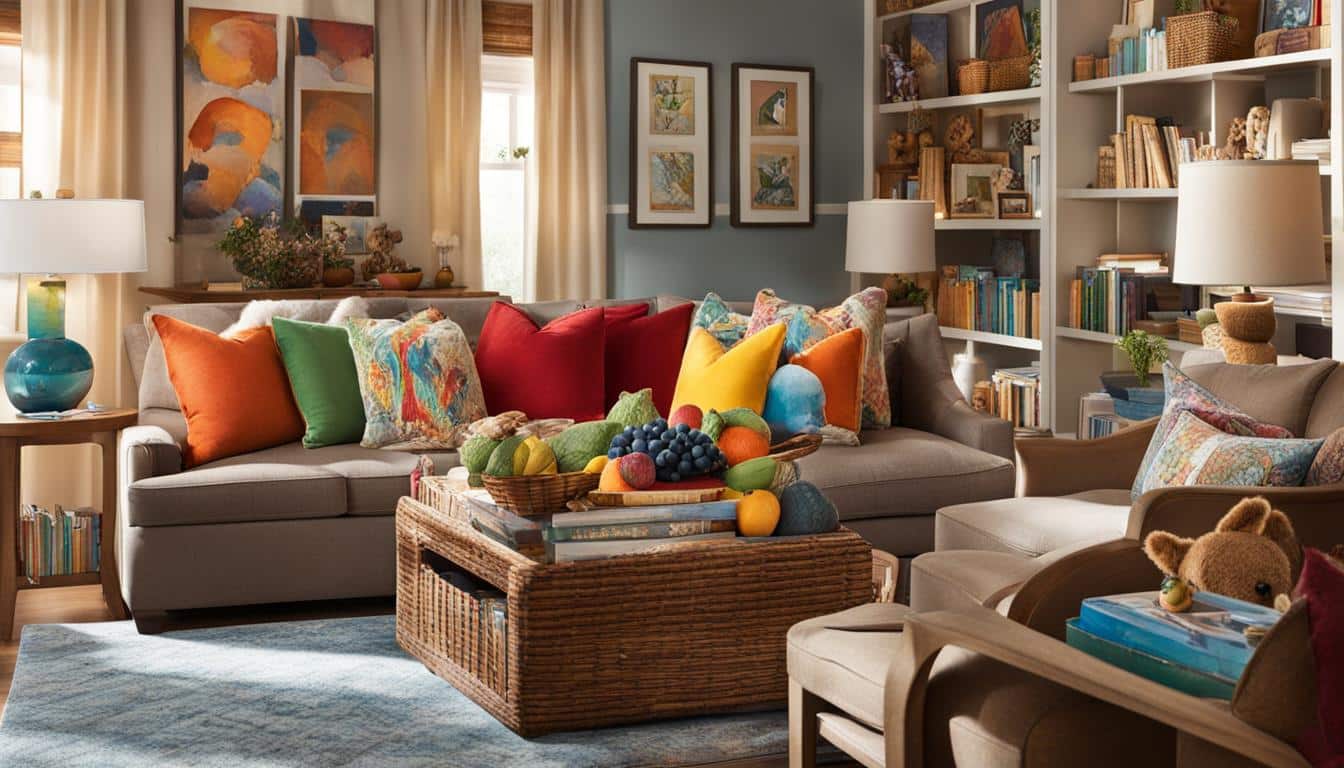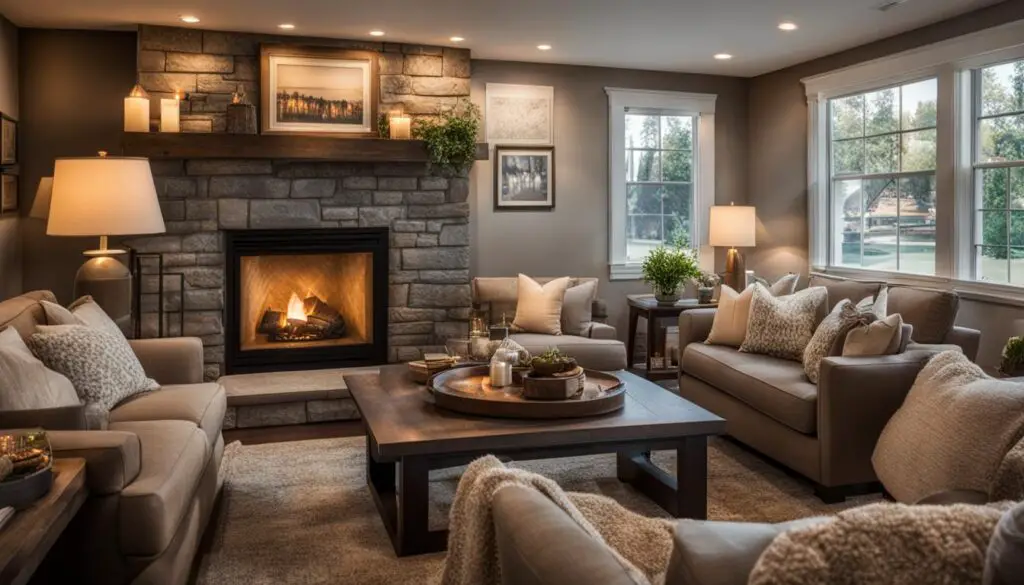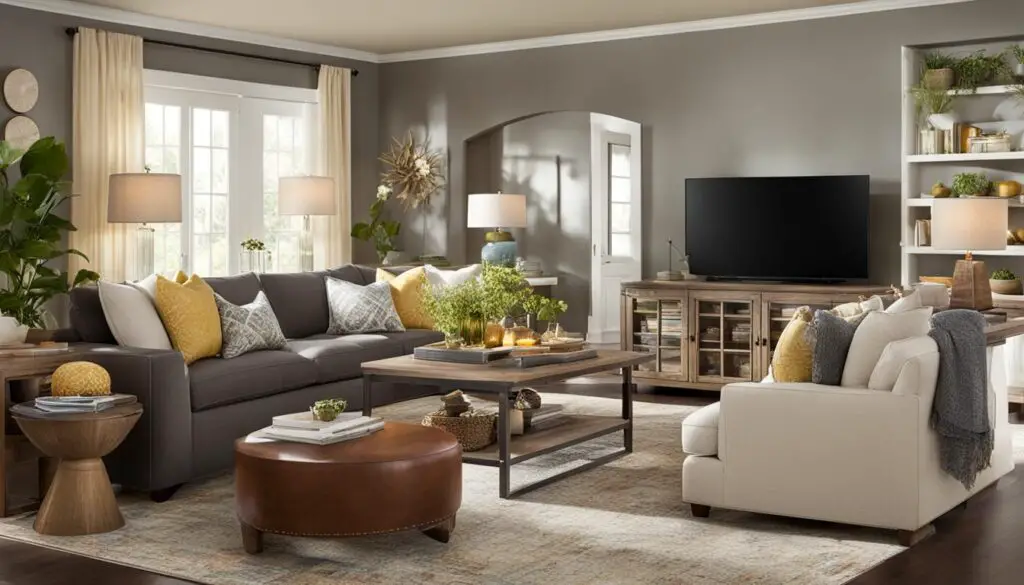
Creating a Family-Friendly Home Environment
If you have children at home, you understand the need to create a kid-friendly environment. While homes can pose safety challenges for younger family members, there are plenty of ways to address common obstacles. Turning your home into a family-friendly space does not mean sacrificing your preferred design style. Implement these 9 top tips for making a kid-friendly home:
- Choose furniture with soft, rounded edges
- Anchor large furniture to prevent tipping
- Use washable interior paints
- Opt for hardwood and vinyl flooring
- Incorporate area rugs
- Provide ample storage space
- Install pool alarms
- Use retractable gates for stairs
- Install security cameras for remote monitoring
Key Takeaways:
- Implement furniture with soft, rounded edges to minimize accidents.
- Anchor large furniture to prevent tipping and potential injuries.
- Use washable interior paints for easy cleanup of spills and messes.
- Opt for hardwood and vinyl flooring for hassle-free cleaning.
- Incorporate area rugs to create a comfortable space for kids to play on.
Tips for Kid-Friendly Home Decor
When creating a family-friendly home environment, it’s important to consider incorporating kid-friendly home decor. By selecting furniture and decor with soft, rounded edges, you can minimize the risk of accidents and injuries. Choose pieces that are not only stylish but also safe for children to be around.
Opt for washable interior paints that can withstand the inevitable spills and messes that come with a family household. This will make it easier to clean up and maintain a fresh and attractive living space.
When it comes to flooring, hardwood and vinyl are excellent options for their durability and ease of cleaning. They can handle the wear and tear caused by children’s activities and are also resistant to spills and stains.
Consider adding area rugs to provide a comfortable and inviting space for your kids to play on the floor. Rugs not only create a designated play area but also add warmth and coziness to the room.
Incorporating ample storage space is crucial for keeping your home organized and clutter-free. Utilize shelves, cabinets, and storage bins to neatly stow away toys, clothes, and accessories. This will not only enhance the overall look of your home but also make it easier for children to find and put away their belongings.
Remember, creating a child-friendly home doesn’t mean sacrificing style. You can still achieve a visually appealing living space while prioritizing safety and functionality.
“By selecting kid-friendly home decor, you can create a safe and visually appealing living space for your family.”
| Tip | Description |
|---|---|
| Choose furniture with soft, rounded edges | Minimize the risk of accidents and injuries |
| Opt for washable interior paints | Easily clean up spills and messes |
| Use hardwood and vinyl flooring | Hassle-free cleaning |
| Incorporate area rugs | Create a comfortable play area for kids |
| Provide ample storage space | Organize toys, clothes, and accessories |
Ensuring Safety in a Kid-Friendly Home
Creating a safe home for kids is a top priority when it comes to designing a family-friendly living space. By implementing the following safety measures, you can provide a secure environment for your children:
1. Anchoring Furniture
To prevent accidents and tipping, anchor large furniture such as bookshelves, dressers, and TV stands securely to the wall. This ensures that they won’t accidentally fall over and harm your children.
2. Pool Alarms
If you have a pool in your backyard, installing pool alarms is essential. These alarms will alert you whenever someone falls into the pool, helping you respond quickly in case of an emergency.
3. Retractable Gates
Stairs pose a significant risk to young children. Install retractable gates at the top and bottom of staircases to prevent accidental falls. These gates are convenient as they can be easily opened and closed when needed.
4. Security Cameras
For additional peace of mind, consider installing security cameras in key areas of your home. This allows you to remotely monitor the living spaces and keep an eye on your children when you’re not in the same room.
5. Cabinet and Outlet Locks
Make sure to secure cabinets and outlets to prevent children from accessing potentially dangerous items or inserting objects where they don’t belong. Use childproof locks and covers to keep these areas safe.
6. Sharp Edge Protectors
Sharp edges on furniture, countertops, and other surfaces can pose a risk of injury to young children. Cover these edges with protective padding to minimize the chance of accidents.
By taking these safety precautions, you can create a family-friendly living space that prioritizes the well-being of your children.
| Safety Measure | Description |
|---|---|
| Anchoring Furniture | Securely anchor large furniture to the wall to prevent tipping. |
| Pool Alarms | Install alarms around the pool area to alert you when someone falls in. |
| Retractable Gates | Use gates at the top and bottom of stairs to prevent falls. |
| Security Cameras | Install cameras for remote monitoring of your living spaces. |
| Cabinet and Outlet Locks | Secure cabinets and outlets to prevent access to dangerous items. |
| Sharp Edge Protectors | Cover sharp edges with protective padding to reduce the risk of injury. |
Promoting Comfort in a Family-Friendly Home
In addition to safety considerations, creating a comfortable home environment is key when designing a family-friendly space. It’s important to prioritize both functionality and comfort for your family’s well-being. By carefully selecting furniture and decor, you can create a welcoming and relaxing atmosphere that everyone will enjoy.
When choosing furniture for your family-friendly home, opt for pieces that are not only practical but also comfortable. Consider investing in cozy seating options like plush sofas and armchairs, providing a comfortable place for your family to relax and unwind. Soft furnishings such as throw pillows and blankets can also enhance the comfort of your living spaces.
In terms of flooring, select materials that are comfortable to walk and sit on. Carpet and area rugs are excellent choices as they add a cozy touch to your home while providing a soft surface for your family to play and spend time together. These additions can transform any space into an oasis of comfort.
Adding cushions and pillows to your seating areas can instantly elevate the comfort level of your family-friendly home. They not only provide extra support but also add a touch of style and coziness to your decor. Experiment with different textures, colors, and patterns to create a warm and inviting ambiance.
Comfort is an essential aspect of a family-friendly home. By selecting furniture and decor that prioritize both style and comfort, you can create a space where your family feels relaxed and at ease. Remember, a comfortable home is a haven for making lifelong memories.
Creating a comfortable home is not only about the physical elements but also about the overall ambiance. By focusing on both safety and comfort, you can foster an environment that promotes happiness and well-being for your entire family.

Encouraging Communication and Bonding
A family-friendly living space is not only about creating a safe and comfortable environment but also fostering communication and bonding among family members. When designing your home, consider incorporating these tips to encourage meaningful connections:
- Create designated spaces for family activities, such as a dedicated living room or playroom. These areas provide a central location for family members to come together and engage in shared experiences.
- Arrange furniture in a way that promotes conversation and interaction. Position seating areas facing each other to encourage face-to-face communication.
- Provide comfortable seating options for family discussions and bonding time. Choose cozy sofas or chairs that invite family members to relax and engage with one another.
- Incorporate elements like a family calendar or message board to keep everyone informed and connected. These visual aids can serve as reminders and facilitate communication about important events or household updates.
By designing a family-friendly living space that encourages communication and bonding, you can create an atmosphere where relationships thrive and family members feel connected.

Building Stronger Relationships
Fostering communication and bonding within the family can have numerous benefits, including:
- Improved understanding: Regular communication helps family members better understand each other’s thoughts, feelings, and needs.
- Enhanced emotional support: Strong family bonds create a support network where individuals can seek comfort and guidance during challenging times.
- Shared experiences and memories: By regularly engaging in activities together, families can create lasting memories and strengthen their sense of unity.
- Effective conflict resolution: Open lines of communication enable family members to address conflicts and resolve issues in a constructive, respectful manner.
“Families that communicate and bond together are more likely to have happier and healthier relationships.”
Ultimately, a family-friendly living space that promotes communication and bonding can contribute to a positive and harmonious family dynamic, creating a strong foundation for lasting relationships.
Cultivating a Positive Family Atmosphere
Creating a family-friendly home environment involves more than just the physical aspects. It’s crucial to cultivate a positive family atmosphere that fosters love, communication, and cooperation. By designing a family-friendly home that prioritizes these values, you can create a harmonious and nurturing space for everyone.
“Communication is key to building a strong and supportive family.”
Encouraging open communication is essential in creating a positive family atmosphere. Provide a safe and judgment-free space for your children to express themselves. Encourage them to share their thoughts, feelings, and experiences, and actively listen to what they have to say. By promoting open dialogue, you can strengthen family bonds and build trust.
“Actions speak louder than words, so show your love and appreciation.”
Show love and affection for each other through both words and actions. Express your appreciation for your family members and acknowledge their efforts. Simple gestures like hugs, kisses, and kind words can go a long way in creating a loving and nurturing environment. Small acts of kindness and thoughtfulness can make a big difference in fostering a positive family atmosphere.
“Respect is the foundation of a positive family environment.”
Foster respect among family members by promoting kindness, empathy, and understanding. Teach your children to treat others with respect and encourage them to resolve conflicts in a peaceful and constructive manner. Set a good example by respecting each family member’s boundaries, opinions, and individuality. By cultivating a culture of respect, you create a safe and inclusive environment for everyone.
“Promote teamwork and cooperation through shared responsibilities.”
Promote cooperation and a sense of belonging by involving each family member in household tasks and activities. Assign age-appropriate chores and encourage everyone to contribute to maintaining a clean and organized home. By working together as a team, you teach your children the value of responsibility, teamwork, and cooperation.
“Prioritize quality time together as a family.”
Make spending quality time together a priority in your family-friendly home. Plan regular family activities, such as game nights, movie nights, or outdoor adventures, to create shared experiences and lasting memories. Disconnect from technology and fully engage with one another. By dedicating time to connect and bond, you strengthen family relationships and build a positive family atmosphere.
| Benefits of a Positive Family Atmosphere |
|---|
| 1. Improved communication and understanding |
| 2. Reduced conflict and increased harmony |
| 3. Enhanced emotional well-being and resilience |
| 4. Strengthened family bonds and relationships |
| 5. Nurtured self-esteem and confidence |
Conclusion
Creating a family-friendly home environment is crucial in providing a safe and nurturing space for your loved ones. By implementing the tips mentioned above and incorporating strategies such as choosing kid-friendly home decor, ensuring safety measures, promoting comfort and communication, and cultivating a positive family atmosphere, you can transform your house into a family-friendly living space.
Remember, creating a family-friendly home is an ongoing process that requires attention to detail and continuous efforts. By making these changes today, you can enjoy the benefits of a family-friendly living environment that is both functional and nurturing for your entire family.
Start by choosing furniture with rounded edges, anchoring large furniture, and using washable paints to address safety concerns. Consider incorporating hardwood and vinyl flooring, area rugs, and ample storage space for comfort and organization. Encourage communication and bonding by creating designated family spaces and providing comfortable seating. Lastly, foster a positive family atmosphere by promoting open communication, respect, and quality time together.
By following these guidelines, you can create a family-friendly living space that promotes safety, comfort, and a strong sense of togetherness. Make the necessary changes today to enjoy the benefits of a family-friendly home environment for years to come.
FAQ
What are some tips for creating a family-friendly home environment?
Some tips for creating a family-friendly home environment include choosing furniture with soft, rounded edges, anchoring large furniture to prevent tipping, using washable interior paints, opting for hardwood and vinyl flooring, incorporating area rugs, providing ample storage space, installing pool alarms, using retractable gates for stairs, and installing security cameras for remote monitoring.
How can I incorporate kid-friendly home decor in my living space?
You can incorporate kid-friendly home decor by choosing furniture and decor with soft, rounded edges to minimize accidents. Opt for washable interior paints to easily clean up spills and messes. Use hardwood and vinyl flooring for hassle-free cleaning. Consider adding area rugs to provide a comfortable space for kids to play on the floor. Incorporate ample storage space to organize toys, clothes, and accessories.
What safety measures should I consider in a kid-friendly home?
Safety measures to consider in a kid-friendly home include anchoring large furniture to prevent tipping, installing pool alarms to alert you when someone has fallen in, using retractable gates to prevent falls on stairs, installing security cameras for remote monitoring of your living spaces, locking cabinets and outlets, and covering sharp edges with protectors.
How can I promote comfort in a family-friendly home?
You can promote comfort in a family-friendly home by choosing furniture and decor that is not only functional but also comfortable. Provide cozy seating options and soft furnishings. Opt for flooring materials that are comfortable to walk and sit on, such as carpet or area rugs. Consider adding cushions and pillows for extra comfort.
How can I encourage communication and bonding in a family-friendly home?
To encourage communication and bonding in a family-friendly home, create designated spaces for family activities such as a living room or a playroom. Arrange furniture in a way that promotes conversation and interaction. Provide comfortable seating options for family discussions and bonding time. Incorporate elements like a family calendar or a message board to keep everyone informed and connected.
How can I cultivate a positive family atmosphere in my home?
To cultivate a positive family atmosphere in your home, encourage open communication and create a safe space for your children to express themselves. Show love and appreciation for each other through words and actions. Foster respect among family members and teach children to treat others with kindness. Promote cooperation and working together on household tasks and activities. Lastly, make it a priority to spend quality time together as a family.